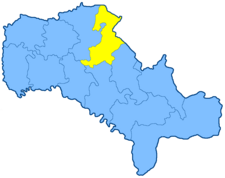Vinnitsa uezd
Vinnitsa uezd Винницкій уѣздъ | |
|---|---|
 Location in the Podolia Governorate | |
| Country | Russian Empire |
| Krai | Southwestern |
| Governorate | Podolia |
| Established | 1795 |
| Abolished | 1923 |
| Capital | Vinnitsa |
| Area | |
| • Total | 2,980.92 km2 (1,150.94 sq mi) |
| Population (1897) | |
| • Total | 248,314 |
| • Density | 83/km2 (220/sq mi) |
| • Urban | 12.31% |
| • Rural | 87.69% |
The Vinnitsa uezd[a] was a county (uezd) of the Podolian Governorate of the Russian Empire. The uezd bordered the Zhitomir uezd of the Volhynian Governorate to the north, the Berdichev uezd of the Kiev Governorate to the northeast, the Bratslav uezd to the east, the Yampol uezd to the south, and the Litin uezd to the west. The administrative centre of the county was Vinnitsa (modern-day Vinnytsia). The county composed most of Vinnytsia Raion of contemporary Ukraine.
Administrative divisions
[edit]The subcounties (volosts) of the Vinnitsa uezd in 1912 were as follows:[1]
| Name | Name in Russian | Capital |
|---|---|---|
| Bolshoi-Ostrozhek volost | Больше-Острожецкая волость | Bolshoi-Ostrozhek |
| Brailov volost | Браиловская волость | Brailov |
| Gavrishovka volost | Гавришовская волость | Gavrishovka |
| Kalinovka volost | Калиновская волость | Kalinovka |
| Maloe-Kutyshche volost | Мало-Кутыщанская волость | Maloe-Kutyshche |
| Pikov volost | Пиковская волость | Pikov |
| Stanislavchik volost | Станиславчикская волость | Stanislavchik |
| Strizhavka volost | Стрижавская волость | Strizhavka |
| Tyvrov volost | Тывровская волость | Tyvrov |
| Yuzvin volost | Юзвинская волость | Yuzvin |
Demographics
[edit]At the time of the Russian Empire Census on 28 January [O.S. 15 January] 1897, the Vinnitsa uezd had a population of 248,314, including 127,006 men and 121,308 women. The majority of the population indicated Little Russian[b] to be their mother tongue, with significant Jewish, Great Russian and Polish speaking minorities.[4]
| Language | Native speakers | Percentage |
|---|---|---|
| Little Russian[b] | 184,847 | 74.44 |
| Jewish | 30,742 | 12.38 |
| Russian[b] | 17,664 | 7.11 |
| Polish | 12,690 | 5.11 |
| Bashkir | 634 | 0.26 |
| Tatar | 539 | 0.22 |
| German | 352 | 0.14 |
| White Russian[b] | 231 | 0.09 |
| Czech | 186 | 0.07 |
| Mordovian | 80 | 0.03 |
| Chuvash | 56 | 0.02 |
| Gipsy | 56 | 0.02 |
| Cheremis | 53 | 0.02 |
| Latvian | 37 | 0.01 |
| French | 26 | 0.01 |
| Votyak | 25 | 0.01 |
| Romanian | 19 | 0.00 |
| Other | 77 | 0.03 |
| Total | 248,314 | 100.00 |
Notes
[edit]- ^
- ^ a b c d Prior to 1918, the Imperial Russian government classified Russians as the Great Russians, Ukrainians as the Little Russians, and Belarusians as the White Russians. After the creation of the Ukrainian People's Republic in 1918, the Little Russians identified themselves as "Ukrainian".[2] Also, the Belarusian Democratic Republic which the White Russians identified themselves as "Belarusian".[3]
References
[edit]- ^ Волостныя, станичныя, сельския, гминныя правления и управления, а также полицейские станы всей России с обозначением места их нахождения [Volostny, stanichnaya, rural, communes of government and administration, as well as police camps throughout Russia with the designation of their location]. Kiev: Izd-vo T-va L. M. Fish. 1913. p. 162. Archived from the original on 2022-12-11.
- ^ Hamm, Michael F. (2014). Kiev: A Portrait, 1800–1917. Princeton University Press. p. 83. ISBN 978-1-4008-5151-5.
- ^ Fortson IV, Benjamin W. (2011). Indo-European Language and Culture: An Introduction. John Wiley & Sons. p. 429. ISBN 978-1-4443-5968-8.
- ^ a b "Демоскоп Weekly - Приложение. Справочник статистических показателей". www.demoscope.ru. Retrieved 2019-12-19.


 French
French Deutsch
Deutsch